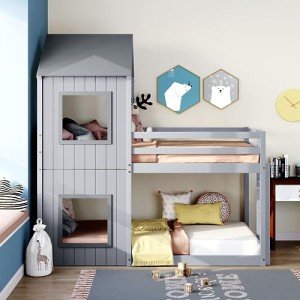
Toddler Bunk Beds
Add a review FollowOverview
-
Founded Date June 4, 1983
-
Sectors Real Estate
-
Posted Jobs 0
Company Description
Bunk Beds House Tools To Ease Your Everyday Lifethe Only Bunk Beds House Technique Every Person Needs To Be Able To
The Comprehensive Guide to Bunk Beds House: Maximizing Space and Functionality
Bunk beds are becoming significantly popular in modern-day households, especially for those residing in restricted space. Whether in a child’s bedroom, a visitor space, and even a getaway home, bunk beds offer an ingenious solution for taking full advantage of space while likewise accommodating numerous sleepers. This post looks into the numerous aspects of bunk beds, their design choices, benefits, and considerations for maintenance to assist anyone thinking about a bunk bed purchase make an informed choice.

Understanding Bunk Beds
Bunk beds are a type of bed that includes one bed stacked on top of another, usually protected by a ladder or built-in stairs. They are frequently made from wood or metal, with styles varying from traditional to modern. Bunk beds are most frequently utilized in kids’s spaces, guest lodgings, and summer season camps, but they can also be a great addition to small apartments or homes.

Kinds Of Bunk Beds
Comprehending the ranges of bunk beds can help one pick the best design for one’s needs. Here are the typical types:
| Type | Description | Pros | Cons |
|---|---|---|---|
| Requirement Bunk | 2 beds stacked on top of each other | Space-saving, timeless design | Limited sleeping capacity for adults |
| Loft Bed | A bed elevated with open space below for a workspace or play location | Offers extra functional space | Not ideal for younger kids |
| Futon Bunk beds house | A bed on top, frequently with a futon on the bottom | Versatile for sleeping and seating | Less stability compared to standard bunks |
| L-Shaped Bunk | Two beds set up in an L-shape, often with storage choices | Distinct design, can suit corners | Uses up more space than standard bunk beds |
| Triple Bunk | 3 beds arranged vertically or in an unique setup | Maximizes sleeping space | Higher risk of accidents, more complex to make |
Advantages of Bunk Beds
Bunk beds offer various benefits, making them a practical furnishings choice for different living spaces. The benefits consist of:
- Space Efficiency: Perfect for little spaces, they permit more floor space, making it easier to move around.
- Dual Functionality: Especially when it comes to loft-style beds, the space underneath can be utilized for a research study area, a play zone, or extra storage.
- Social Interaction: Bunk beds develop a sense of friendship among siblings or roomies, promoting sharing and bonding.
- Cost-efficient Sleeping Solution: They supply a cost effective method to accommodate multiple guests without the need to invest in extra separate beds.
- Design Variety: With options ranging from smooth modern-day designs to timeless wooden structures, there is a bunk bed style to fit any decoration.
Essential Considerations for Bunk Beds
While bunk beds offer multiple benefits, there are certain considerations to remember to ensure safety and longevity:
- Weight Capacity: Always inspect the weight limit of the bunk bed to avoid accidents. The majority of standard bunk beds have weight capabilities in between 200-400 pounds.
- Product Quality: Opt for durable products such as strong wood or top-quality metal to guarantee stability and longevity.
- Safety Features: Look for designs with guard rails on the top bunk and broad ladders. Make sure that the bed feet are steady and secure.
- Age Appropriateness: Young children need to not sleep in the top bunk, as the threat of falling is significantly increased.
- Assembly: Some bunk beds can be intricate to put together. Ensure that good guidelines are readily available, or consider expert assembly.
Upkeep of Bunk Beds
Proper upkeep of bunk beds is important for ensuring their comfort and security. Here are some suggestions for maintenance:
- Regular Inspections: Periodically check the stability of the bed, guaranteeing all screws and elements are tight and safe.
- Cleaning: Dust the furnishings routinely and clean any spills instantly to keep the integrity and appearance of the beds.
- Mattress Care: Rotate mattresses periodically to prevent wear and drooping. Think about hypoallergenic mattress protectors for added comfort and cleanliness.
- Adjust if Moved: If the bed is relocated, adjust all parts to make sure continued security and stability.
Frequently Asked Questions about Bunk Beds
Q1: Are bunk beds safe for children?A1: Yes, as long as security standards are complied with. Make sure the leading bunk has guardrails, which kids are old sufficient and accountable enough to safely use the leading bunk. Q2: How much weight can a bunk
bed support?A2: Most bunk beds support between 200 to 400 pounds per bed
, but this can vary by design. Always describe the maker’s specifications. Q3: Can adults sleep in bunk beds?A3: Yes, lots of modern-day bunk beds are
created to accommodate adults, especially those with reinforced frames. Q4: Do bunk beds require unique mattresses?A4: Not necessarily. Standard mattresses can be used as long as they fit the
measurements supplied by the maker. Nevertheless,
think about utilizing thinner bed mattress for the leading bunk to guarantee security clearance. Q5: How can I optimize space in a room with bunk beds?A5: Use the area underneath for storage or desks, and think about including vertical storage
services to keep the space uncluttered. Bunk beds use an excellent option for maximizing space in a home while offering a stylish and practical sleeping plan. Whether for a child’s space, a guest space, or a holiday house, they are a flexible alternative that can accommodate different requirements. By thinking about types, benefits, and proper maintenance, people can make informed choices, making sure security and durability in their bunk bed financial investment. With mindful choice, bunk beds can enhance both comfort and visual appeal in any room.
